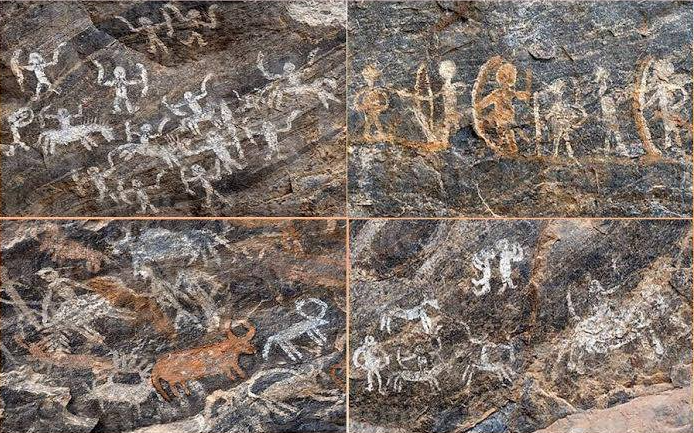A collective of the youth of the Irula tribal community, Porivarai has successfully managed to go beyond sports and games activities to take up sustainable enterprises.

An interview with Kannan, one of the founders of Porivarai, fills us in on how the initiative began and where it stands now.
Tell us about how Porivarai started and why you chose the name “Porivarai”?

5000-year-old Pre - Historic Rock Paintings. Drawing of Deer, Bull, Mangoose, Elephant, and figures of Human beings.
In the year 2018, some of us in the Irula community decided to start a youth club to bring the youth in the community together for various activities and to generate fellowship and camaraderie among them. Porivarai is a prehistoric cave painting site that has rock paintings dating to over 2000 years ago and Karikkaiyur, one of the villages where the youth hails from, is the closest habitation to Porivarai. When we were deciding on a name for our club, Porivarai seemed apt. We registered as a youth club in Ooty in 2018. The Porivarai team, comprising both boys and girls, began with just 20 members from five villages—Karikkaiyur, Karaipanai, Maligopu, Nadoor and Bargur. We are about 35 members now.
What are the activities of Porivarai and how did Keystone help with them?
In the beginning, we focused largely on games and sports activities—the youth in the villages took part in sports activities and organised matches with other village youths. We had financial constraints since all the activities were funded by ourselves. Later we felt why would we limit ourselves to sports and games alone? Why can’t we work towards earning an income through this collective?

After much deliberation, we started with beekeeping in 2019. The forest department distributed 100 bee boxes to the Karikkaiyur village. We knew how to collect honey through the traditional method but beekeeping was new to us and posed newer challenges. We attended workshops and training on beekeeping before we got used to it and started earning a very good income through the method. Later on, when we discussed starting a new initiative, we got the idea of organic fertilisers and pesticides. We attended training conducted by the government for us through which we learned to prepare five types of organic inputs like Panchagavyam, Meen amilam, Dasagavyam, Amardhakarisham and Poochi veratti. We approached Keystone Foundation which supported us in selling them and also helped us in making the preparations better. We used these fertilisers and pesticides in our farms and found them to be very effective.
What is Porivarai’s work around conserving Irula traditions?

Musical Instruments have done after attending workshop in SVARAM, Auroville: Rattle (Kappa Kilikalapai), Whistle and Bamboo Drums
Traditional music: Music is an integral part of our lives but we felt our music traditions were slowly fading. That’s when Keystone Foundation came up with ideas to revitalise it through Porivarai. After a few meetings with Keystone, we took the initiative to teach music to the younger ones. We needed a space for that and that led to building a small house for the Porivarai youth club to conduct music classes. Every evening, we got village elders to share music traditions with the youth. We had a scarcity of musical instruments. Keystone took us to a workshop conducted by SVARAM— Musical Instruments and Research where we learnt newer ways of playing music and to bring natural sound from instruments made from bamboo. We got an idea to create instruments from the bamboo, like flute, whistle, rattle, bamboo drums and so on. In the beginning, we were creating these instruments with knives and other tools which took months to complete. But the People and Nature Collective at the Keystone gave us a machine to do the finishing work which has been very helpful for us to complete our work quicker

Bamboo Traditional Crafts: Baskets, Murram, etc.
Traditional crafts: We later extended our work to creating traditional bamboo crafts like baskets, winnow, etc. The youth picked up the craft from the village elders but were very sure that we will not do it as a business because we didn’t want to ruin forest resources. So, we limited the supply of bamboo crafts within the community itself. In hindsight, this was a good move, as various customs demand use of these products which we didn’t know how to procure earlier. Now that we make it ourselves, there is no shortage of products and people in the community have started approaching us.

Kwol Radio
Broadcasting stories: We also felt we were losing our culture as the younger generation was losing touch with ancient customs followed in the community. Keystone Foundation gave us ideas on ways to preserve our customs and stories and how to pass them on to the younger generations. Kwol Radio in Porivarai is a result of that. We collect stories on ancient ways of living from the elders in the community and we broadcast them through Kwol radio that reaches people living within a 100m radius.



Works at Porivarai

Images: Deepika Vijayan & Keystone Foundation
Finally, Kannan concluded by saying initially we had all the works done in a different place then we decided to bring all our works together in one place. So we decided to construct a house for the Porivarai, youth club. We built it ourselves using mud, grass, and bamboo. Now Porivarai has a president, secretary, and six advisors and we regularly meet to discuss various projects and work. Seeing our work, some youth in the neighboring villages too are coming up with community initiatives like Porivarai.

